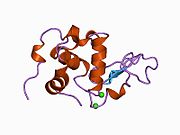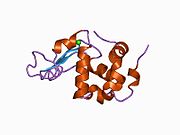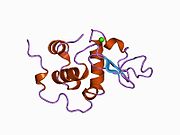α-Lactalbumin
| LALBA | |||
|---|---|---|---|
Gene ontology | |||
| Molecular function | |||
| Cellular component | |||
| Biological process | |||
| Sources:Amigo / QuickGO | |||
Ensembl | |||||||||
|---|---|---|---|---|---|---|---|---|---|
| UniProt | |||||||||
| RefSeq (mRNA) | |||||||||
| RefSeq (protein) | |||||||||
| Location (UCSC) | Chr 12: 48.57 – 48.57 Mb | Chr 15: 98.38 – 98.38 Mb | |||||||
| PubMed search | [3] | [4] | |||||||
| View/Edit Human | View/Edit Mouse |
α-Lactalbumin, also known as LALBA, is a protein that in humans is encoded by the LALBA gene.[5][6][7]
Overview
α-Lactalbumin is a protein that regulates the production of lactose in the milk of almost all mammalian species.[8] In primates, α-lactalbumin expression is upregulated in response to the hormone prolactin and increases the production of lactose.[9]
α-Lactalbumin forms the regulatory subunit of the
When formed into a complex with Gal-T1, a galactosyltransferase, α-lactalbumin, enhances the enzyme's affinity for glucose by about 1000 times, and inhibits the ability to polymerise multiple galactose units. This gives rise to a pathway for forming lactose by converting Gal-TI to Lactose synthase.
Physical properties
The structure of α-lactalbumin is well known and is composed of 123 amino acids and 4 disulfide bridges. The molecular weight is 14178 Da, and the
Evolution
The sequence comparison of α-lactalbumin shows a strong similarity to that of lysozymes, specifically the Ca2+-binding c-lysozyme.[12] These two proteins share much of their physical structure but contain less than half of the same amino acid sequence and therefore vary in function drastically.[11] So, the expected evolutionary history is that gene duplication of the c-lysozyme was followed by mutation, resulting in the loss of lysozyme catalytic activity in α-lactalbumin.[8][13] This gene predates the last common ancestor of mammals and birds, which probably puts its origin at about 300 Ma.[14]
Functions
Current research is finding new application of α-lactalbumin outside the physiological lactose production.
Nutrition: α-Lactalbumin is essential for newborn nutrition. This protein provides essential amino acids and bioactive compounds necessary for optimal growth, development, and health. α-Lactalbumin is the most abundant whey protein in human milk and its properties have been researched to include in infant formulas to replicate mammary milk compounds. This protein is a strong source of branched amino acids, cysteine, and tryptophan residues, each with correlated health benefits.[15]
Clinical Uses: α-Lactalbumin has been researched in conjunction with many different medical conditions and is thought to correlate with positive outcomes. Many of these benefits are due to the bioactive compounds it is made of and the protein’s ability to bind complexes.[13]
PCOS: Polycystic Ovary Syndrome (PCOS) is one disease that higher levels of α-lactalbumin have been linked with relieving symptoms. This condition is closely linked with gut dysbiosis caused by inflammation of the intestinal lining and a microbiota imbalance. α-Lactalbumin promotes healthy bacterial strains such as Lactobacillus acidophilus, Bifidobacterium short, and Bifidobacterium longum. These bacteria produce short chain fatty acids (SCFA) which improve the gut biome. In a controlled study, the group that ate a diet higher in α-lactalbumin experienced a decrease in symptoms associated with PCOS, and higher levels of healthy bacteria. While there isn’t a cure for this condition, this could be a short-term remedy.[16]
Mental health: α-Lactalbumin is a source of amino acids which are connected to improved mental health. This protein is rich in Tryptophan residues which are a precursor to serotonin, a neurotransmitter associated with positive moods. The protein also increases the plasma concentration for other large neutral amino acids (LNAAs) which help balance hormones. The cysteine residues aid in glutathione synthesis which is an important antioxidant.[15][16]
Cancer: There has been extensive research on apoptotic effects that α-lactalbumin potentially has when it forms a complex with oleic acid called HAMLET (Human alpha-lactalbumin made lethal to tumor cells). This HAMLET complex disrupts the structure of the membrane when bound, promoting cell death to protect the integrity of the organism. This complex can translocate into the nuclei of cancerous cells, but not of healthy cells. When in cancer cells, this protein-OA complex has been shown to slow the progression of tumors in numerous studies. α-Lactalbumin's native state does not show these same anti-cancer functions, so it is likely that the oleic acid expresses the apoptotic functions while the α-lactalbumin is responsible for targeting the specific cells lines such as colon, bladder, and glioblastoma cancer cells.[13]
References
- ^ a b c GRCh38: Ensembl release 89: ENSG00000167531 – Ensembl, May 2017
- ^ a b c GRCm38: Ensembl release 89: ENSMUSG00000022991 – Ensembl, May 2017
- ^ "Human PubMed Reference:". National Center for Biotechnology Information, U.S. National Library of Medicine.
- ^ "Mouse PubMed Reference:". National Center for Biotechnology Information, U.S. National Library of Medicine.
- ^ a b "Entrez Gene: LALBA lactalbumin, alpha-".
- PMID 6163135.
- PMID 2954544.
- ^ PMID 9307874.
- PMID 6575400.
- PMID 11575938.
- ^ PMID 32825311.
- PMID 2769757.
- ^ PMID 35539089.
- S2CID 10039589.
- ^ PMID 34095293.
- ^ PMID 35956395.
Further reading
- Heine WE, Klein PD, Reeds PJ (March 1991). "The importance of alpha-lactalbumin in infant nutrition". The Journal of Nutrition. 121 (3): 277–283. PMID 2002399.
- Permyakov EA, Berliner LJ (May 2000). "alpha-Lactalbumin: structure and function". FEBS Letters. 473 (3): 269–274. S2CID 83964232.
- Hall L, Emery DC, Davies MS, Parker D, Craig RK (March 1987). "Organization and sequence of the human alpha-lactalbumin gene". The Biochemical Journal. 242 (3): 735–742. PMID 2954544.
- Davies MS, West LF, Davis MB, Povey S, Craig RK (July 1987). "The gene for human alpha-lactalbumin is assigned to chromosome 12q13". Annals of Human Genetics. 51 (3): 183–188. S2CID 37901087.
- Findlay JB, Brew K (May 1972). "The complete amino-acid sequence of human -lactalbumin". European Journal of Biochemistry. 27 (1): 65–86. PMID 5049057.
- Hall L, Craig RK, Edbrooke MR, Campbell PN (June 1982). "Comparison of the nucleotide sequence of cloned human and guinea-pig pre-alpha-lactalbumin cDNA with that of chick pre-lysozyme cDNA suggests evolution from a common ancestral gene". Nucleic Acids Research. 10 (11): 3503–3515. PMID 6285305.
- Håkansson A, Zhivotovsky B, Orrenius S, Sabharwal H, Svanborg C (August 1995). "Apoptosis induced by a human milk protein". Proceedings of the National Academy of Sciences of the United States of America. 92 (17): 8064–8068. PMID 7644538.
- Stacey A, Schnieke A, Kerr M, Scott A, McKee C, Cottingham I, et al. (March 1995). "Lactation is disrupted by alpha-lactalbumin deficiency and can be restored by human alpha-lactalbumin gene replacement in mice". Proceedings of the National Academy of Sciences of the United States of America. 92 (7): 2835–2839. PMID 7708733.
- Fujiwara Y, Miwa M, Takahashi R, Hirabayashi M, Suzuki T, Ueda M (June 1997). "Position-independent and high-level expression of human alpha-lactalbumin in the milk of transgenic rats carrying a 210-kb YAC DNA". Molecular Reproduction and Development. 47 (2): 157–163. S2CID 43232515.
- Lindner RA, Kapur A, Carver JA (October 1997). "The interaction of the molecular chaperone, alpha-crystallin, with molten globule states of bovine alpha-lactalbumin". The Journal of Biological Chemistry. 272 (44): 27722–27729. PMID 9346914.
- Giuffrida MG, Cavaletto M, Giunta C, Neuteboom B, Cantisani A, Napolitano L, et al. (November 1997). "The unusual amino acid triplet Asn-Ile-Cys is a glycosylation consensus site in human alpha-lactalbumin". Journal of Protein Chemistry. 16 (8): 747–753. S2CID 42107172.
- Chandra N, Brew K, Acharya KR (April 1998). "Structural evidence for the presence of a secondary calcium binding site in human alpha-lactalbumin". Biochemistry. 37 (14): 4767–4772. PMID 9537992.
- Håkansson A, Andréasson J, Zhivotovsky B, Karpman D, Orrenius S, Svanborg C (February 1999). "Multimeric alpha-lactalbumin from human milk induces apoptosis through a direct effect on cell nuclei". Experimental Cell Research. 246 (2): 451–460. PMID 9925761.
- Svensson M, Sabharwal H, Håkansson A, Mossberg AK, Lipniunas P, Leffler H, et al. (March 1999). "Molecular characterization of alpha-lactalbumin folding variants that induce apoptosis in tumor cells". The Journal of Biological Chemistry. 274 (10): 6388–6396. PMID 10037730.
- Harata K, Abe Y, Muraki M (March 1999). "Crystallographic evaluation of internal motion of human alpha-lactalbumin refined by full-matrix least-squares method". Journal of Molecular Biology. 287 (2): 347–358. PMID 10080897.
- Last AM, Schulman BA, Robinson CV, Redfield C (August 2001). "Probing subtle differences in the hydrogen exchange behavior of variants of the human alpha-lactalbumin molten globule using mass spectrometry". Journal of Molecular Biology. 311 (4): 909–919. PMID 11518539.
- Bai P, Peng Z (November 2001). "Cooperative folding of the isolated alpha-helical domain of hen egg-white lysozyme". Journal of Molecular Biology. 314 (2): 321–329. PMID 11718563.
- Andrews P (August 1970). "Purification of lactose synthetase a protein from human milk and demonstration of its interaction with alpha-lactalbumin". FEBS Letters. 9 (5): 297–300. S2CID 23041445.
External links
- alpha-Lactalbumin at the U.S. National Library of Medicine Medical Subject Headings (MeSH)
- Human LALBA genome location and LALBA gene details page in the UCSC Genome Browser.





